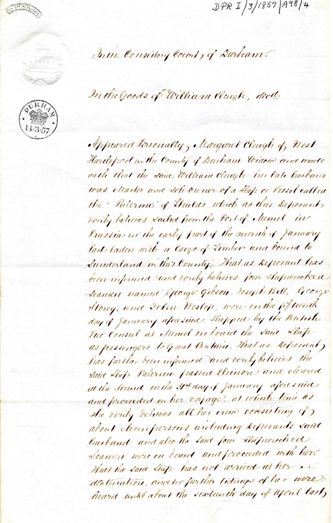The wreck of the Palermo

This short article will briefly explore the information presented in the Cleugh probate records, and will plot only an outline of the events around the wreck of the Palermo. The full story of the wreck must, however, be taken as a work in progress, and one in which the visitors to the North East Inheritance (NEI) site are heartily invited to participate. Many details of the twists and turns of the Palermo's last voyage, and that of her crew and unlucky passengers, might be traced in a number of archives both in the United Kingdom, Norway and perhaps elsewhere, and the NEI project is happy to promote and accept any additions to this short history, either in the form of acknowledged supplements to this article, or in hyperlinks to other archives online.
An affidavit is a "statement made in writing, confirmed by the maker's oath, and intended to be used as judicial proof" [OED]. This was that of Cleugh's widow and next of kin, and so the person most fitted to make such a statement. It was made on 30 May 1857, and thus some six weeks had passed since Margaret Cleugh had been informed by the Registrar General of Seamen of the discovery of her husband's ship 'dismasted and waterlogged' off the Norwegian coast, news of which discovery on 2 March 1857 had taken six weeks to reach her. The Palermo cleared the sound at Elsinore on 31 January 1857 bound for the East coast of England, and we might guess that Margaret Cleugh might have been anxious for news from the latter days of February. She had had enough time since she first learned of the disaster to collect a few more facts and to prepare a full statement. In this she was no doubt helped by the volume of international trade passing through north-eastern ports to Norwegian waters. Her sureties - those persons willing to financially guarantee her liability for the penal sum to the bishop of Durham - included her husband's uncle and both were similarly occupied in a variety of mercantile trades on the river Tyne. So we may be moderately certain that any definite news to be had about the sinking would have been passed around the North Sea and the maritime community, finally reaching its sad destination in Mrs Cleugh at West Hartlepool. Of course, only that information directly relevant to the proof of death and her request for a grant of administration would have been included in the affidavit, and it may be that Margaret Cleugh knew or guessed more about the circumstances of the disaster than the court required her to declare.
The wreck of the Palermo drew a measure of attention in the press at the time, but these and other strands might perhaps be drawn together later. The bare facts emerging from the affidavit are these: the Palermo took on a cargo of timber at Memel in Prussia (now Klaipėda, Lithuania) and left that port bound for Sunderland in England early in January 1857, clearing the sound of Elsinore or Helsingør in Denmark on 31 January 1857. It was not until two months later on 2 March 1857 that the dismasted wreck was discovered by a Norwegian pilot off the island of Kinn (in the municipality of Florø, Norway), some 136km north of Bergen and 296km north of Stavanger. The ship was dismasted and waterlogged, and six bodies were discovered in the forecastle, one of which was carrying by papers identifying it as the body of Joseph Bell. Bell was one of four sailors, all survivors of the Halcyon, a Hull vessel wrecked in the Baltic and shipped on to the Palermo by the British Vice Consul at Memel as passengers back to England. William Cleugh's body was not positively identified among the dead, but the affidavit clearly states his widow's belief that "husband and all the others of the crew and passengers on board the said Ship "Palermo" except those whose bodies were found as before deposed have been washed overboard and were drowned or lost at sea". All this information appears to have been made known to Mrs Cleugh by the Registrar General of Seamen, a United Kingdom merchant shipping authority which maintained records and registrations of merchant shipping and crews. In addition, the affidavit states that the hulk of the Palermo later drifted into Hofden (Hovden) some 10km to the North, where it was sold as wreck and broken up.
 |
Previous page | Map | Next page |  |

